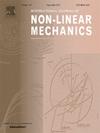高超声速冲激装置膜片断裂动力学分析的FEM-SPH自适应方法
IF 2.8
3区 工程技术
Q2 MECHANICS
International Journal of Non-Linear Mechanics
Pub Date : 2025-04-15
DOI:10.1016/j.ijnonlinmec.2025.105123
引用次数: 0
摘要
冲击隧道是用于研究超音速飞机空气动力性能的重要陆基试验设施。隔膜是冲击隧道试验的重要组成部分,它起着触发装置的作用。膜片的临界破裂压力非常重要,因为它决定了冲击隧道试验的工作条件。然而,膜片破裂时会产生碎片,对试验设备的安全运行构成风险。有限元法(FEM)是分析隔膜破裂动态响应最常用的方法。虽然有限元法可以准确预测临界破裂压力和破裂时间,但在模拟破裂过程中产生的碎片方面存在局限性。本文针对这一局限性,提出了一种结合有限元法和平滑粒子流体力学(FEM-SPH)计算冲击隧道隔膜破裂动态响应的方法。该方法在预测临界破裂压力和时间方面的准确性已得到验证。此外,论文还介绍了一种利用聚集 SPH 粒子表征碎片的研究方法。它分析了膜片和碎片在破裂过程中的动态响应特性。本文章由计算机程序翻译,如有差异,请以英文原文为准。
FEM-SPH adaptive method for dynamic analysis of the diaphragm's fracture in hypersonic impulse facilities
The shock tunnel is a key land-based test facility used to study the aerodynamic performance of supersonic aircraft. The diaphragm is an essential component of the shock tunnel test, which acts as the trigger device. The critical rupture pressure of the diaphragm is significant because it determines the operating conditions for the shock tunnel test. However, when the diaphragm ruptures, it generates fragments that can pose risks to the safe operation of the test equipment. The finite element method (FEM) is the most commonly used approach for analyzing the dynamic response of diaphragm rupture. While FEM can accurately predict the critical rupture pressure and rupture time, it has limitations in simulating the fragments produced during the rupture process. This paper proposes a method for calculating the dynamic response of a shock tunnel diaphragm rupture by combining the finite element method and smoothed particle hydrodynamics (FEM-SPH) to address this limitation. This method has been verified for its accuracy in predicting critical rupture pressure and time. Additionally, the paper introduces a research method for characterizing the fragments using aggregated SPH particles. It analyzes the dynamic response characteristics of the diaphragm and the pieces during the rupture process.
求助全文
通过发布文献求助,成功后即可免费获取论文全文。
去求助
来源期刊
CiteScore
5.50
自引率
9.40%
发文量
192
审稿时长
67 days
期刊介绍:
The International Journal of Non-Linear Mechanics provides a specific medium for dissemination of high-quality research results in the various areas of theoretical, applied, and experimental mechanics of solids, fluids, structures, and systems where the phenomena are inherently non-linear.
The journal brings together original results in non-linear problems in elasticity, plasticity, dynamics, vibrations, wave-propagation, rheology, fluid-structure interaction systems, stability, biomechanics, micro- and nano-structures, materials, metamaterials, and in other diverse areas.
Papers may be analytical, computational or experimental in nature. Treatments of non-linear differential equations wherein solutions and properties of solutions are emphasized but physical aspects are not adequately relevant, will not be considered for possible publication. Both deterministic and stochastic approaches are fostered. Contributions pertaining to both established and emerging fields are encouraged.

 求助内容:
求助内容: 应助结果提醒方式:
应助结果提醒方式:


